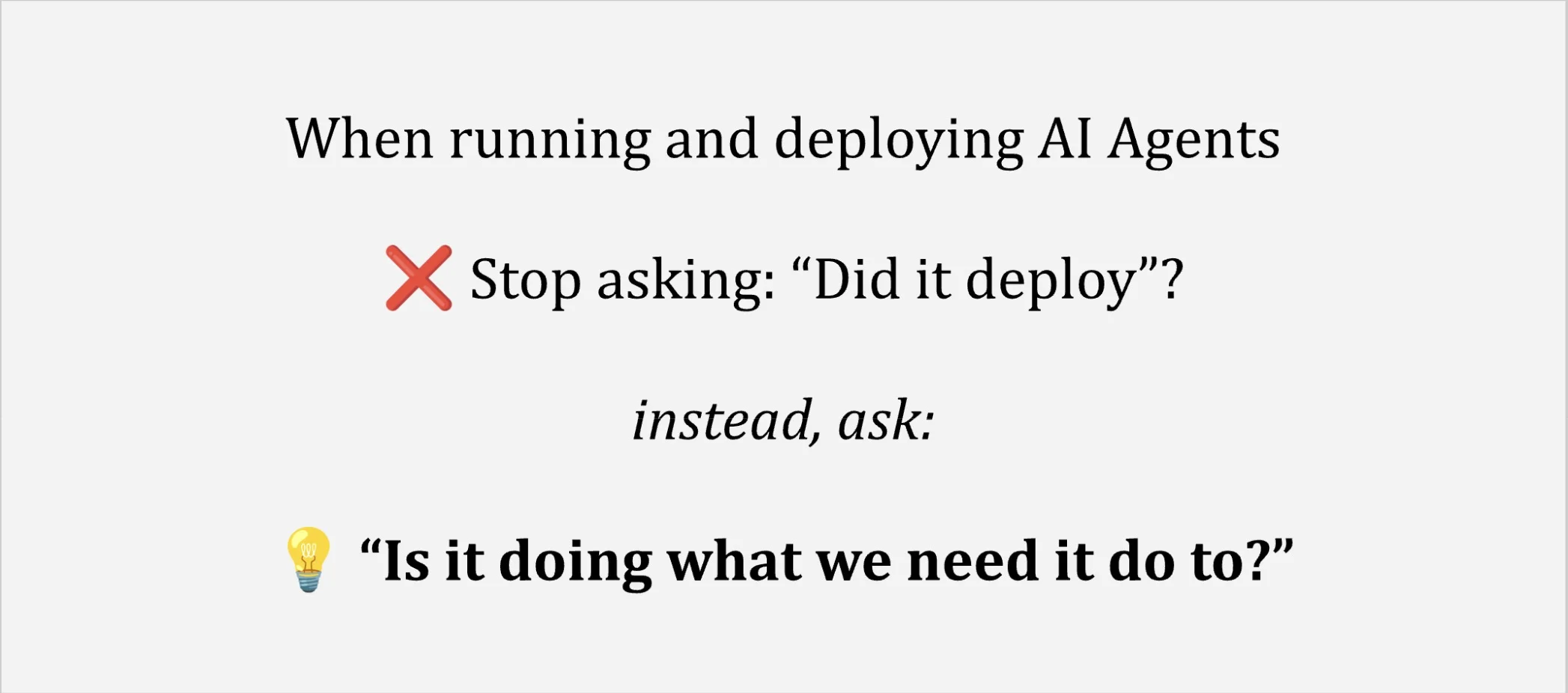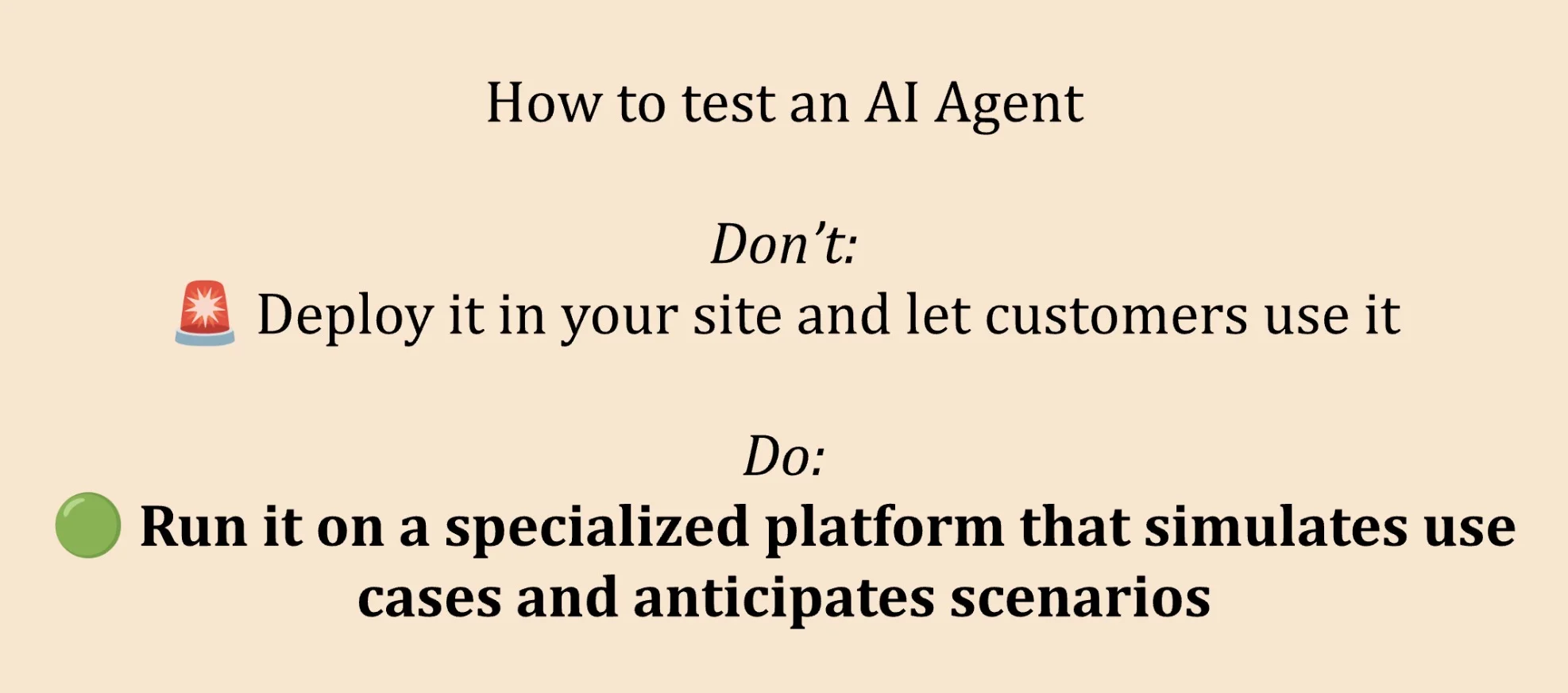
Luis Minvielle
May 22, 2025
By 2026, Gartner predicts that investments in generative AI will lead to a 20% to 30% reduction in the number of human customer service agents. At the same time, it will create new roles focused on building and managing these AI systems.
For Customer Care experts and businesses, this shift is already happening. Now, the question is: how do you deploy AI agents that can effectively take over those tasks?
The first step is clear: deploy AI agents that can handle real customer interactions. But it doesn’t end there. Once your agent is live, the focus shifts to making sure it works as expected. Proper testing is a necessary step to achieve this.

In this article, we’ll walk you through the process of deploying AI agents with Genezio and explain why regular testing is just as important as deployment to make sure your AI agents deliver in real-world interactions.
What are AI agents?
AI agents are software programs that can interact with users, systems, or data using natural language models (LLMs) or task-based logic. They are built to simulate a kind of human-like decision-making to answer questions, summarize documents, complete actions, or respond to events in real time.
In a business context, they can help automate customer interactions, monitor workflows, or trigger backend processes. For instance, Customer Care Executives often use AI agents to answer support queries, route tickets, or gather client feedback. In other teams, they might assist with internal tools, analyze logs, or complete routine tasks automatically.
But because AI agents generate responses based on probability , they don’t always get it right. That’s why regular testing with the right tools is important. It makes sure AI agents stay always reliable, compliant and on track.
What does it mean to deploy AI agents?
To deploy AI agents means setting them up in an environment where they can run (like a serverless platform), and then placing them in the application where they are supposed to work: your website, customer support chat, backend service, or internal dashboard.
This step takes the code you’ve written and turns it into a running service that can interact with users or other systems. For example, if a support chatbot has been trained and tested in development, deployment means connecting it to your website or app where customers will actually use it.
At this point, it’s useful to pause. AI agents aren’t like regular code or web apps. With apps, you might worry about bugs or crashes. With agents, you’re dealing with something a little trickier: behavior. Even if the deployment works technically in production, your agent might still hallucinate, go off-topic, or return incomplete responses.
So, if you’re a customer care executive or a business owner, it’s not enough to ask: “Did it deploy?” This is because IT staff, or an IT contractor, will surely be able to deploy it, at least under the proper definition of “deploy.”
What you also need to ask is**: “Does it behave how we expect?”**
This is why testing is not a separate phase. It’s part of deployment, especially when AI is involved.
How to deploy AI agents in a few steps
In this example, we’ll use two tools that work well together. Lovableis a solution to build full-stack web apps. It’s not specialized on AI agents, but it’s a fast way to get your project started and pushed to GitHub. Genezio takes over from there, and gives you a place to deploy, test, and manage your AI agent without the need to set up extra infrastructure or worry about server configurations.
⚠️ Disclaimer: If you’re a Customer Care executive, you can skip this section altogether, because someone working in tech will handle it. But you’ll want to read on to understand how you can then test an AI agent.
If your agent code is already on GitHub, or if you generate it using Lovable, you can follow this step-by-step guide to deploy AI agents with Genezio:
Step 1: Create your project in Lovable and link it to GitHub
Lovable gives you a quick way to code a working web app. After generating your project, you can connect it to GitHub with one click. Lovable handles the GitHub authorization and pushes your code automatically, so you get a clean, version-controlled codebase without the need to set anything up manually. It’s a good first step if you are new to GitHub and want to start fast.
Step 2: Import your code into DeployApps and deploy
Once your code is on GitHub, head over to DeployApps. Log in , hit Import from GitHub, and drop in your repo URL. After authorizing DeployApps, it sets up everything behind the scenes for you: backend, hosting, and scaling. Your AI agent is now a live service, ready to interact with users or plug into your internal tools.
Step 3: Set up your custom domain (optional)
DeployApps gives you a default subdomain right away, so your agent is live as soon as it’s deployed. If you want something more branded, go to your Project Settings, open the Custom Domain section, and add your preferred subdomain. You can also bring your own domain if you want, and Genezio walks you through the DNS setup from the dashboard.
With these few steps, your agent is live and ready to answer simple customer questions or handle more complex tasks like ticket triaging or order tracking. But that’s only half the job.
Why testing AI agents is a necessary part of the deployment process
Deployment alone doesn’t show how your agent will perform. Real customers don’t ask simple, predictable questions. They interrupt, repeat, use slang, or bring up sensitive topics. If your agent can’t handle that, it will fail where it matters most: live interactions.
Real-world examples show how quickly things can go wrong. Microsoft’s Tay , a Twitter bot released in 2016, became toxic within hours after interacting with users and had to be shut down. In 2023, Bing’s AI chatbot gave emotional and confused replies, and even told a user it was in love with them. And these weren’t isolated cases. They were regular interactions that reveal how fragile an AI system can be without proper testing.
The same risks apply across industries. In banking, a chatbot might misquote fees or expose personal data. In healthcare, it could offer unsafe advice. We all know how that might end—and it’s not good.

This is why the right testing becomes a necessary part of the deployment process. Genezio lets you test AI agents against realistic input, and flag issues like hallucinations, prompt injection, and off-policy responses. Customer Care executives can review how an agent responds in complex real-world scenarios, not only in controlled environments. And since Genezio keeps monitoring after launch, any shift in behavior can be spotted sooner than later.
Deploy and test AI agents with DeployApps
Deploying AI agents is faster than ever—especially with DeployApps, where you can link your GitHub project, skip the backend setup, and get your agent live without dealing with infrastructure. But once the agent is live, it’s important to see how it performs in real conversations. For Customer Care Executives, this is what makes the difference.
That’s why testing matters just as much as deployment.
If you’re ready to deploy AI agents that actually hold up in the real world, Genezio makes it easy to get started. Get Your Independent Chatbot Evaluation Now — or book a quick demo to see how it works.
Article contents
Subscribe to our newsletter
DeployApps is a serverless platform for building full-stack web and mobile applications in a scalable and cost-efficient way.
Related articles
More from AI
Multilingual Customer Service: Cost of Multilingual Misfires in AI Customer Service
Luis Minvielle
Jun 30, 2025





